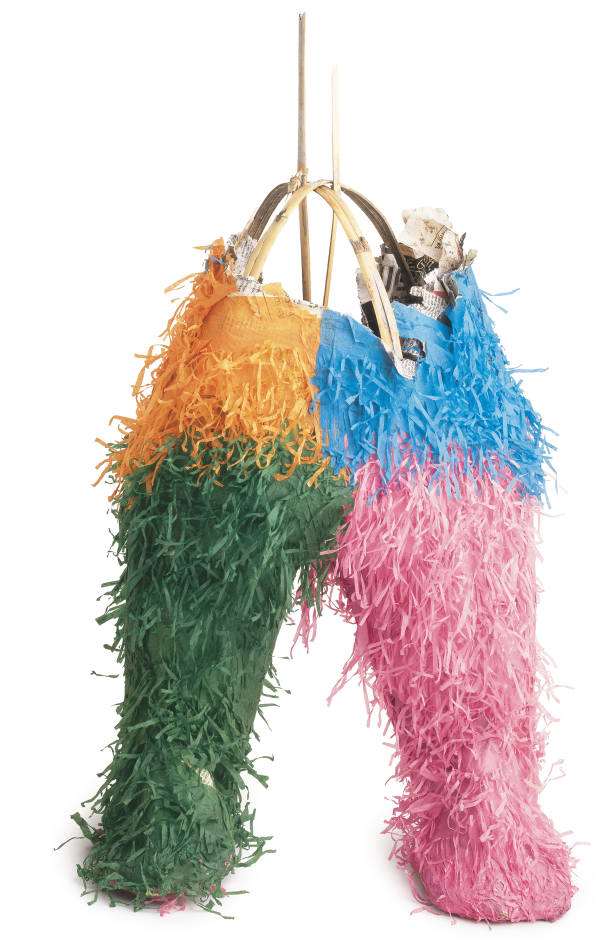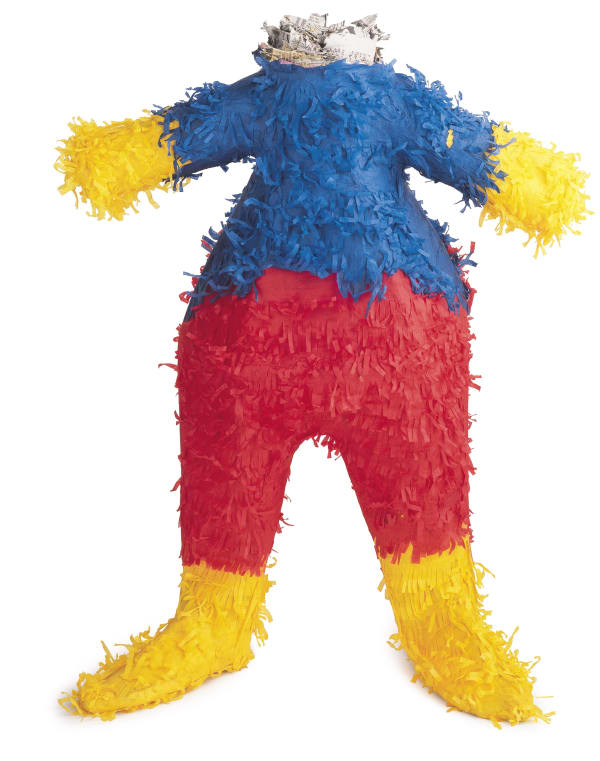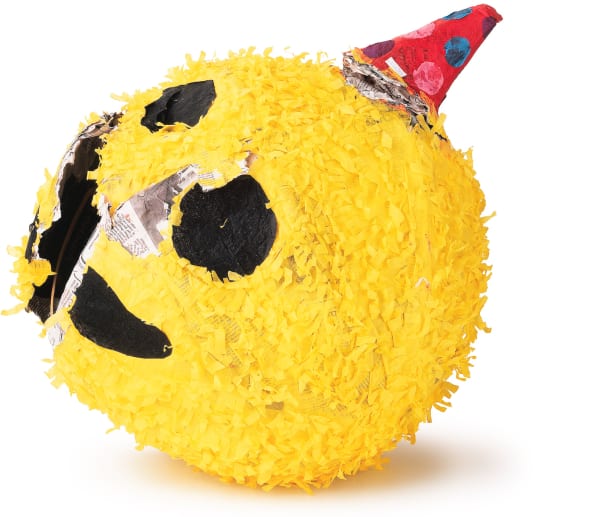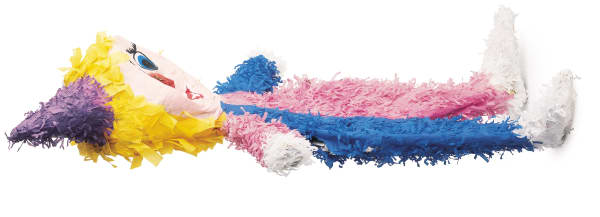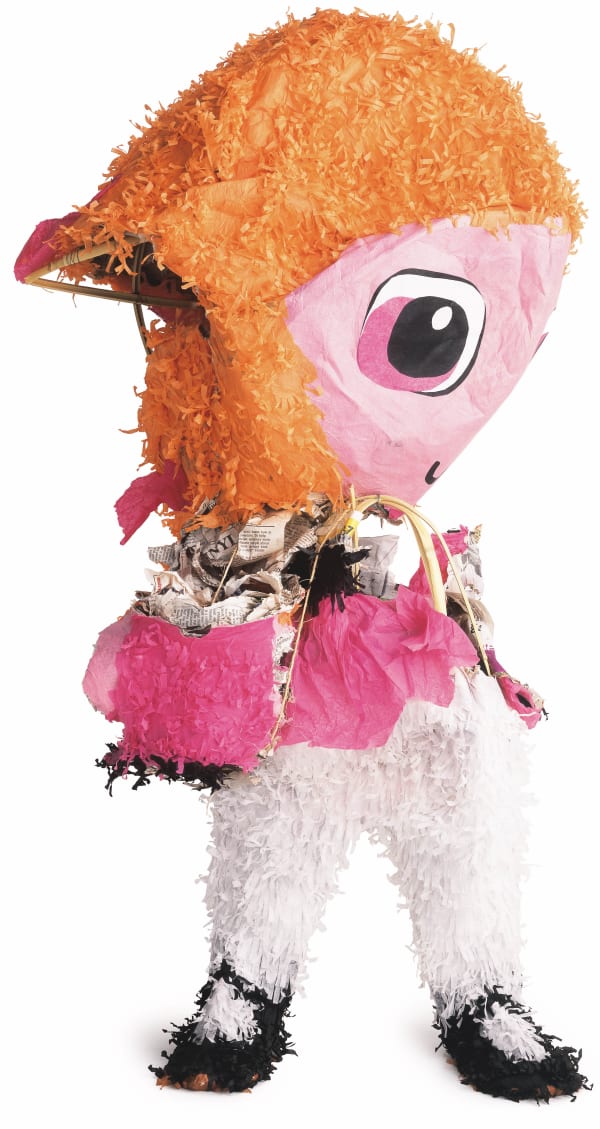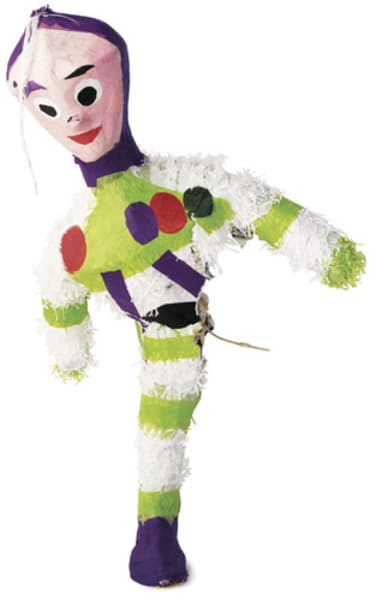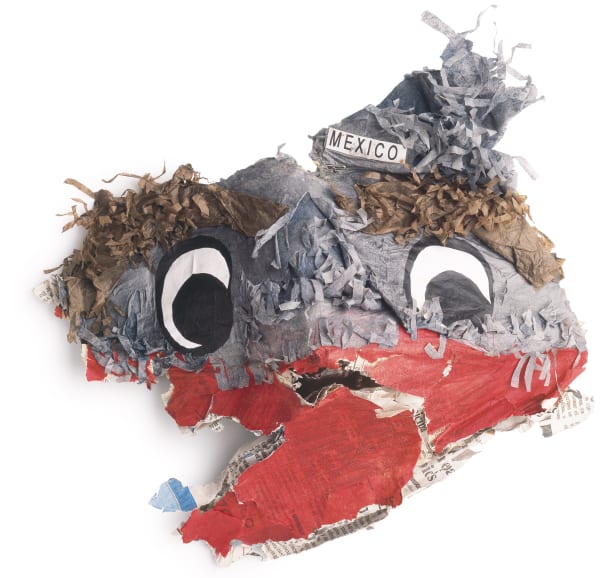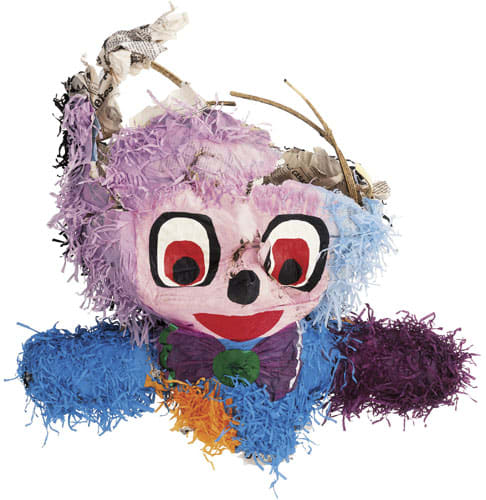Piñata 2002-3
"Chuck Ramirez came into this world with an eagle’s detail-devouring eye. In his Piñata series (2002), Ramirez puts his eye to complex narrative use: each image zeroes in on the material detritus of a past event and displays the swept-up and forsaken. Ramirez’ photographic technique in the Piñata series and elsewhere employs an almost molecular focus and a light both pitiless and exalting. With an initial blast of color, the comical intent of each party sculpture appears readily. But each torn paper limb and ruffle, each glimpse of spindly wooden skeleton and bulge of newspaper stuffing suggests a deep pathos behind the early impressions of humor. In lesser hands, a photo series of freshly-whacked piñatas could have taken on all the glibness and slick irreverence of a kitsch mexicanismo. It could have come off sentimental. For Ramirez, though, his worldview lies in the particulars; he doesn’t present piñatas with a pop, but with subversive gravitas. His awareness of his own mortality is too finely attuned, his queerness too gritty and his anger too potent to contain itself in mere punchlines. Ramirez also made evident his ambivalence towards Mexican and Mexican-American culture; an identity he claimed firmly and dismissed irreverently in turn, but never fully turned away from. The Piñata series exemplifies Ramirez’ respect for handiwork and, of course, rasquache.
As an art director and graphic designer, Ramirez could stage, light and shoot consumer products as if they were movie stars, could render them into glorious mysteries of the tangible and incite longing and even envy. In the Piñata series, there’s nothing for us to want except the image. We want what Ramirez sees, which is the violent and abandoned underpinnings of celebration. Each piñata downfall is distinct—note Scott, with its small-scale but potent damage, versus Andrea, all woeful faced, labeled “MEXICO.” Ramirez named the images after his friends, but this seems rather arbitrary. The titles cast the piñatas as characters, male or female, the name offering a gender unmoored from any gender apparent in the object. This juxtaposition of first names with martyred post-party relics—all head or no head, splayed and partial—conjure a harrowing human comedy and endlessly contorted romanticism. An absent somebody made each of these piñatas by hand, knowing they’d be destroyed. An unseen somebody else—possibly Ramirez himself—brought them to their expected end. If ever they contained candy, it’s gone now and the children have left the party."
-Essay by Sarah Fisch
-
 Chuck RamirezPiñata: Carrot, 2003Pigment inkjet print, edition of 6 and 10 respectively60 x 48 in, 152.4 x 121.9 cm
Chuck RamirezPiñata: Carrot, 2003Pigment inkjet print, edition of 6 and 10 respectively60 x 48 in, 152.4 x 121.9 cm
or 30 x 24 in, 76.2 x 61 cm -
 Chuck RamirezPiñata: Henry, 2003Pigment inkjet print, edition of 6 and 10 respectively60 x 48 in, 152.4 x 121.9 cm
Chuck RamirezPiñata: Henry, 2003Pigment inkjet print, edition of 6 and 10 respectively60 x 48 in, 152.4 x 121.9 cm
or 30 x 24 in, 76.2 x 61 cm -
 Chuck RamirezPiñata: Hills, 2003Pigment inkjet print, edition of 6 and 10 respectively60 x 48 in, 152.4 x 121.9 cm
Chuck RamirezPiñata: Hills, 2003Pigment inkjet print, edition of 6 and 10 respectively60 x 48 in, 152.4 x 121.9 cm
or 30 x 24 in, 76.2 x 61 -
 Chuck RamirezPiñata: Janette, 2003Pigment inkjet print, edition of 6 and 10 respectively60 x 48 in, 152.4 x 121.9 cm
Chuck RamirezPiñata: Janette, 2003Pigment inkjet print, edition of 6 and 10 respectively60 x 48 in, 152.4 x 121.9 cm
or 30 x 24 in, 76.2 x 61 cm -
 Chuck RamirezPiñata: Judy, 2003Pigment inkjet print, edition of 6 and 10 respectively60 x 48 in, 152.4 x 121.9 cm
Chuck RamirezPiñata: Judy, 2003Pigment inkjet print, edition of 6 and 10 respectively60 x 48 in, 152.4 x 121.9 cm
or 30 x 24 in, 76.2 x 61 cm -
 Chuck RamirezPiñata: Montana, 2003Pigment inkjet print, edition of 6 and 10 respectively60 x 48 in, 152.4 x 121.9 cm
Chuck RamirezPiñata: Montana, 2003Pigment inkjet print, edition of 6 and 10 respectively60 x 48 in, 152.4 x 121.9 cm
or 30 x 24 in, 76.2 x 61 cm -
 Chuck RamirezPiñata: Nate, 2003Pigment inkjet print, edition of 6 and 10 respectively60 x 48 in, 152.4 x 121.9 cm
Chuck RamirezPiñata: Nate, 2003Pigment inkjet print, edition of 6 and 10 respectively60 x 48 in, 152.4 x 121.9 cm
or 30 x 24 in, 76.2 x 61 cm -
 Chuck RamirezPiñata: Alex, 2002Pigment inkjet print, edition of 6 and 10 respectively60 x 48 in, 152.4 x 121.9 cm
Chuck RamirezPiñata: Alex, 2002Pigment inkjet print, edition of 6 and 10 respectively60 x 48 in, 152.4 x 121.9 cm
or 30 x 24 in, 76.2 x 61 cm -
 Chuck RamirezPiñata: Amelia, 2002Pigment inkjet print, edition of 6 and 10 respectively60 x 48 in, 152.4 x 121.9 cm
Chuck RamirezPiñata: Amelia, 2002Pigment inkjet print, edition of 6 and 10 respectively60 x 48 in, 152.4 x 121.9 cm
or 30 x 24 in, 76.2 x 61 cm -
 Chuck RamirezPiñata: Andrea, 2002Pigment inkjet print, edition of 6 and 10 respectively60 x 48 in, 152.4 x 121.9 cm
Chuck RamirezPiñata: Andrea, 2002Pigment inkjet print, edition of 6 and 10 respectively60 x 48 in, 152.4 x 121.9 cm
or 30 x 24 in, 76.2 x 61 cm -
 Chuck RamirezPiñata: Cakky, 2002Pigment inkjet print, edition of 6 and 10 respectively60 x 48 in, 152.4 x 121.9 cm
Chuck RamirezPiñata: Cakky, 2002Pigment inkjet print, edition of 6 and 10 respectively60 x 48 in, 152.4 x 121.9 cm
or 30 x 24 in, 76.2 x 61 cm -
 Chuck RamirezPiñata: Ethel, 2002Pigment inkjet print, edition of 6 and 10 respectively60 x 48 in, 152.4 x 121.9 cm
Chuck RamirezPiñata: Ethel, 2002Pigment inkjet print, edition of 6 and 10 respectively60 x 48 in, 152.4 x 121.9 cm
or 30 x 24 in, 76.2 x 61 cm -
 Chuck RamirezPiñata: Franco, 2002Pigment inkjet print, edition of 6 and 10 respectively60 x 48 in, 152.4 x 121.9 cm
Chuck RamirezPiñata: Franco, 2002Pigment inkjet print, edition of 6 and 10 respectively60 x 48 in, 152.4 x 121.9 cm
or 30 x 24 in, 76.2 x 61 cm -
 Chuck RamirezPiñata: Gregory, 2002Pigment inkjet print, edition of 6 and 10 respectively60 x 48 in, 152.4 x 121.9 cm
Chuck RamirezPiñata: Gregory, 2002Pigment inkjet print, edition of 6 and 10 respectively60 x 48 in, 152.4 x 121.9 cm
or 30 x 24 in, 76.2 x 60.9 cm -
 Chuck RamirezPiñata: Scott, 2002Pigment inkjet print, edition of 6 and 10 respectively60 x 48 in, 152.4 x 121.9 cm
Chuck RamirezPiñata: Scott, 2002Pigment inkjet print, edition of 6 and 10 respectively60 x 48 in, 152.4 x 121.9 cm
or 30 x 24 in, 76.2 x 61 cm


